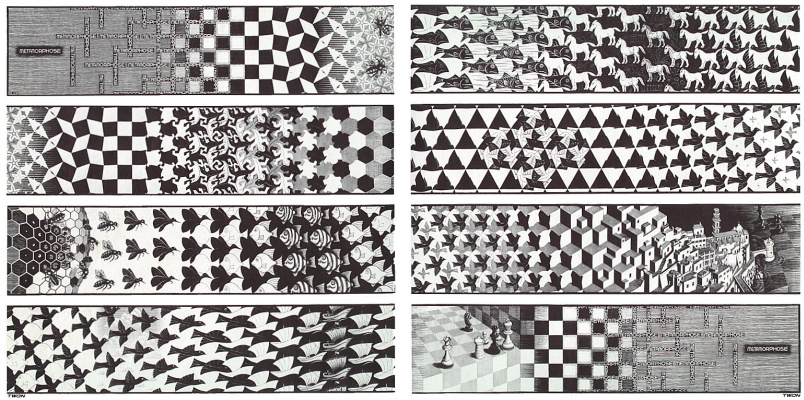log in
Enter site
Login to use Arthive functionality to the maximum
Metamorphosis III
Maurits Cornelis Escher • Gravur, 1968, 19.2×680 cm
Beschreibung des Kunstwerks «Metamorphosis III»
This engraving was Escher’s most ambitious work and a truly grandiose conclusion to his famous series. "Metamorphosis". Occupying almost seven meters in length, assembled from 33 identical blocks, it is the quintessence of all the "mosaic" experiments of the artist, who captured him after traveling to Spain.
Escher visited Alhambra for the first time in the early 20s and even captured one of the mosaic frescoes. But, in all likelihood, in that first serious journey, too much impressions fell upon the young Maurits, and the picturesque Italian landscapes temporarily displaced the Moorish mosaics from his imagination. And the second trip to Spain could well have failed to take place if it were not for Escher’s adventurous undertaking.
The artist and his wife, Jetta, were very upset by the forced departure from Italy, which became their favorite home for both. But Asher found a way to get back there at least for a while. He suggested that the shipping company Adria should take pictures of ships and ports along the way in exchange for free travel. Strangely enough, this proposal was accepted, and Asher and his wife again went to Italy, and then to Spain, where the artist again saw the famous Alhambra mosaics.
The masterly work of Oriental masters, which inspired Escher to create Metamorphoses, was, however, limited by the Islamic ban on the image of living beings. Asher, for whom, it seems, no framework existed in principle, he began to use for his mosaics zoomorphic and anthropomorphic images. In Metamorphoses III, he combined most of the previously used forms (including part of the engraving "Day and night" (1938) in an endless looping pattern, where triangles turn into winged mail envelopes, hexagons and squares turn into lizards, insects turn into birds, and ships turn into fish.
Author: Evgenia Sidelnikova
Escher visited Alhambra for the first time in the early 20s and even captured one of the mosaic frescoes. But, in all likelihood, in that first serious journey, too much impressions fell upon the young Maurits, and the picturesque Italian landscapes temporarily displaced the Moorish mosaics from his imagination. And the second trip to Spain could well have failed to take place if it were not for Escher’s adventurous undertaking.
The artist and his wife, Jetta, were very upset by the forced departure from Italy, which became their favorite home for both. But Asher found a way to get back there at least for a while. He suggested that the shipping company Adria should take pictures of ships and ports along the way in exchange for free travel. Strangely enough, this proposal was accepted, and Asher and his wife again went to Italy, and then to Spain, where the artist again saw the famous Alhambra mosaics.
The masterly work of Oriental masters, which inspired Escher to create Metamorphoses, was, however, limited by the Islamic ban on the image of living beings. Asher, for whom, it seems, no framework existed in principle, he began to use for his mosaics zoomorphic and anthropomorphic images. In Metamorphoses III, he combined most of the previously used forms (including part of the engraving "Day and night" (1938) in an endless looping pattern, where triangles turn into winged mail envelopes, hexagons and squares turn into lizards, insects turn into birds, and ships turn into fish.
Author: Evgenia Sidelnikova


